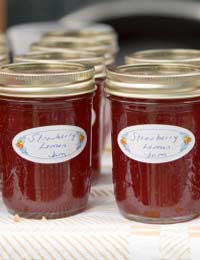
Home-grown berries are magical, there’s nothing better than a sun-ripened strawberry fresh from the plant. If you’re looking for a way to preserve the bounty, read our guide to preserving berries.
Preserving Basics
Jams, jellies, and preserves – what are the differences?
Before you start preserving, make sure that you have enough containers for the finished result. You can buy jam jars or re-use old ones, provided they still have a plastic lining inside the metal lid. Alternatively, you could use wax discs and plastic to cover the pots, in the old-fashioned style. Le Parfait glass jars are also great for jams and jellies, as they can be reused again and again.
You’ll also need a large, stainless steel saucepan, a weighing scales, wooden spoon, and funnel. Before starting any jam recipe, put a couple of small saucers into the freezer to chill.
Once you’ve mastered the steps below, you can try your own combinations using the berries you’ve grown yourself. You can make great jam or jelly from blackberries, raspberries, whitecurrants, blackcurrants, redcurrants, loganberries and boysenberries – or any combination of these. At the beginning or end of the season, you might want to bulk out your berry crops using seasonal fruit: rhubarb, plums and cooking apples are all good ingredients. Strawberry and rhubarb jam is delicious!
The basic steps of jam-making are as follows:
- 1 Select unblemished, just-ripe berries, clean them, and wipe dry.
- 2 Chop large berries in half.
- 3 Put the fruit into the pan with an equal weight of caster sugar (or sugar with added pectin, if using a low-pectin fruit such as strawberries).
- 4 Bring the pan slowly to the boil, stirring occasionally to dissolve the sugar.
- 5 Simmer over a gentle heat until the jam reaches setting point.
- 6 To test for set, drop a teaspoon of the jam onto one of the cold saucers. Leave it for five seconds, then push it with your finger. If it wrinkles, the jam is ready.
To make jelly, wash, and weigh your fruit, then simmer gently in a large pan to soften it. Once it’s softened, tip the berries into a muslin jelly-bag (or a sieve lined with muslin) and leave over a bowl. When all the juice has been rendered, measure it before adding the sugar (check your recipe – it’s usually just less than the volume of the fruit juice). You may also need to add lemon juice, depending on the berry you’ve used (blackcurrant and gooseberries don’t need it). Pour back into the clean pan and boil until setting point has been reached (see 6, above).
Strawberry and Gooseberry Jam
Strawberries are low in pectin, unlike gooseberries and blackcurrants. This combination gives a better set and a great blend of flavours. Following the instructions above for jam, weigh 200g strawberries and 200g gooseberries, add 400g caster sugar, and add lemon juice as required (if no set has been reached within about 10 minutes).
